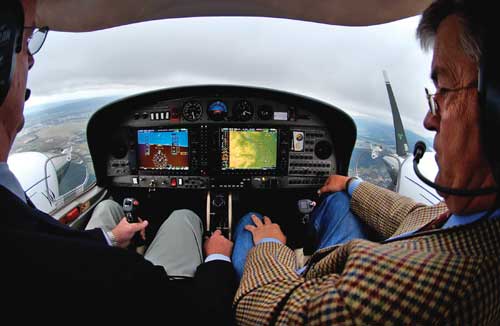
by Karen Workman
The advantages of having an “instrument rating” cannot be disputed. The rating adds a huge margin of safety to your flying, and increases the utility of both your pilot certificate and aircraft. A pilot certificate gives you wings, while an instrument rating gets you from point A to B safely, with confidence, and allows you to go through the clouds that keep others on the ground.
In a perfect world, your instrument rating would be earned like this: You would walk into your FBO to announce that you have successfully passed your written test and are ready to begin the practical part of your instrument training. Twelve (12) certified instrument flight instructors (CFIIs) would be lined up, each of them with thousands of hours of experience. You would be matched up with one that best suits your style. That instructor would dedicate an entire week to only you and at the end of that week, you would be qualified to fly through the clouds with the FAA’s blessing.
Typically, it doesn’t work like that. You walk into an FBO and it is hit or miss. Chances are, the instructor is a young person recently graduated from a fine collegiate aviation program, on his or her way to flying for the airlines, who will try and fit you into a schedule to fly every Wednesday evening for the next six months. Of course, there are no guarantees that you would actually be able to fly all of those Wednesdays, but that’s alright, you can extend the training to eternity until you are ready for your checkride. And if your instructor reaches his/her minimum required hours for a job with a commuter airline, you will be passed on to the next instructor.
Not all flight schools at FBOs operate that way, but there are enough that the best have developed accelerated programs. One company is actually called “Accelerated Flight & Instrument Training” or AFIT.
Instrument Rating In 10 Days
AFIT is a company that was started in California 20 years ago that offers a 10-day instrument training course with highly experienced instructors based at your airport for one fixed fee, guaranteed. I repeat: 10 days, your airport, highly experienced instructor, fixed cost, guaranteed!
Tony Montalte, president of AFIT, points out that few people have the time to drag out training for months on end, nor is it the most effective training method.
“Instrument flight is complex and rust can quickly grow on newly-acquired skills,” says Montalte. “If the last lesson was two weeks ago, much more review is needed than if the last lesson was only a week ago. As one AFIT instructor said, “With us, clients don’t regress, they pro-gress.” The training is always moving forward and building on what was just learned.
Your Airport
There are other flight schools offering accelerated courses, but training is done at their location, in their aircraft. AFIT does have that option with training sites around the country, but most students appreciate that with AFIT, an instructor comes to you and can train in your airplane.
Since many of AFIT’s students are working professionals, the eight to 10-hour training day can start at whatever time of the day the client chooses.
One client of AFIT needed a checkout in a Piper Saratoga he had just purchased in Virginia, and needed an instrument rating. So the instructor met the client in Virginia to pick up the plane, and they flew the new Saratoga back to the client’s home in California, accomplishing the checkout and the training enroute. It was a satisfying, memorable experience for both student and instructor.
Experienced Instructors
![Workman-Scott-Dillion-and-John[1]](https://www.midwestflyer.com/wp-content/uploads/2012/04/Workman-Scott-Dillion-and-John1-300x171.jpg)
All AFIT instructors are over age 55. They are stable and mature. They are in the business of flight training because that is their passion. They are not building hours for a better job. And AFIT instructors are scattered all over the country, and have rich, diverse backgrounds. One instructor, when not instructing, flies a Cessna Turbo 210 at 26,000 feet, conducting atmospheric research for the National Oceanic & Atmospheric Administration.
Cost
Instrument training is the core business of Accelerated Flight & Instrument Training, but the company’s flight instructors also work with students for their private pilot certificate, commercial pilot certificate, and multi-engine rating. Recurrent, transition and glass cockpit training is available as well.
The instrument course has a flat fee of $595 per day and is completed in 10 concurrent days. It begins with four or five days of cross-country flying to establish the primary concepts of instrument flight, to complete the required cross-country flight requirement, and to allow the instructor and student to become acquainted. The rest of the time is spent on approaches and prepping for the oral and flight exams. If training is completed in less than 10 days, the client pays only for the days he/she used.
Success!
The men and women at Accelerated Flight & Instrument Training are dedicated to their client’s success. Their goal is to leave the student confident and competent to fly in instrument conditions. They will fly in actual instrument conditions whenever it is possible during their training.
While the course is guaranteed, it does not mean an instrument rating is assured, but AFIT’s pass rate is 98%. AFIT’s website is chock full of testimonials from business owners, surgeons, attorneys, executives, and professional sports players, all who have taken the time to say “Thank you!”
For additional information about Accelerated Flight & Instrument Training, check out their website at www.afit-info.com, call 866-270-8224, or email afit@cox.net.
EDITOR’S NOTE: Karen Workman is an instrument rated private pilot living in Minnesota with her husband, Eric, who is a CFII. The Workmans own a 1968 Piper Cherokee 180D, and also belong to a flying club where they can fly a Cessna 182RG, Cessna 172, Piper Archer, and a Beech Skipper.